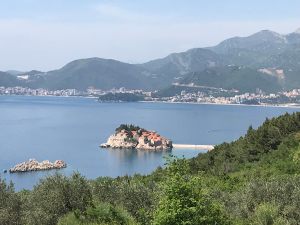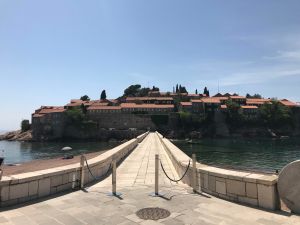The idea of visiting Montenegro had been circling in my head since “Casino Royal” was released. I wanted to visit the casino where mr. Bond won over the international criminal, and hopefully sit at the famous table. Imagine my surprise when I learnt that the actual casino, or the building where the casino in the movie was located, is a hotel in Karlove Vary in Czech Republic. Well, even despite this disappointment, I decided that it was time to travel to Montenegro.

Montenegro is rather small country squeezed between Croatia, Bosnia and Hercegovina, Serbia, Kosovo and Albania, with a coast line to Adriatic Sea. After the recovery of Balkan war, the country had seen a renovation of infrastructure, offering great highways, and increase in construction of several hotels and resorts. These are especially visible in and around Budva.
The good thing is that the country is not very big, hence we rented a car and decided to have an intensive girls weekend amongst breath-taking beaches, turquoise sea and majestic mountains. We stayed in a lovely airbnb in the “bar” area in the capital city as our base. Looking at the trip now, this was very good idea, as after long days spent in the car, going for a dinner was a very simple process.
The road trip started with heading towards the Adriatic Sea with first stop at Lake Skadar. It borders with Albania, it is one of the largest lakes in Europe, and the largest lake in Balkans. Beautiful lash hills surrounding the lake makes it almost a perfect place for picnic.
How many of you have never seen a picture or a postcard with a tiny island that resembles a tiny town hidden behind a wall and one small bridge leading to the land? I am sure that not that many missed it… Sveti Stefan was our next destination.

The first documented mention of Sveti Stefan goes back to 1442, as an advanced guard house. It is written also, that the fort had been built earlier and took its name after the church located in the settlement. Later, in XIX century the fort saw a further development when it counted over 100 houses and 3 churches with 400 inhabitants. This was the time, when the tiny island was at full capacity then.
Today this tiny island is an expensive resort owned by a Singapore based resort operator where only resort guests are allowed to enter. However, this picturesque little town on the rock, offers nice views from the beaches leading to the entrance. Therefore, we placed our beach towels, prepared small lunch out of cheese and tomoatoes, and enjoyed few hours trying to catch first suntan of the year.
The next stop was Budva. Almost a “stone throw away” from Sveti Stefan. The city is in the centre of Budva Municipality and the centre of tourism in Montenegro. It is said that Budva is 2,500 years old, which makes it the oldest settlement on the Adriatic Coast. The history of it dates back to V century B.C. According to the legends, the town was founded by Cadmus, from Greece, after his exile from Thebes.

It is worth mentioning that the city was part of Roman Empire in the II century, and at the fall of the Empire and the division of it to east and west created a defence barrier that run through this area. As a result the city experienced centuries of impact on its history and the culture.
The next Empire, Byzantium Empire, took over Budva under its wings for two centuries in the 6th century. This had been also the period, when Slavs began to arrive and they had mixed with local Roman population.
In the subsequent centuries, after the fall of Byzantium Empire, Budva was ruled by Doclean kings, the Venetians, the Habsburg Monarchy, Russia during the Napoleonic wars, France and then Austrian Empire. After the World War I, the city ca, under ruling of Kingdom of Yugoslavia. Finally, in 2006 Montenegro became independent, with Budva as its primary tourist destination.

The Old Town in Budva offers an insights to life behind defensive stone walls. Dozens of small and narrow streets are filled with people visiting small shops full of typical touristic souvenirs or artsy ornaments, clothes, ladies bags, shoes and many others. I ended with buying a beach blanket… produced in Turkey. One can also sit in one of the cafes by the main wall, with the view of the sea, and sip cool Aperol cocktail.
Outside of stone walls the city is vibrant and alive. Many cafes, restaurants, and bazars can fill days of any tourist whether staying in local hotels, or like us, driving through.
As the day was slowly heading to an end, the last stop on our agenda was Kotor, located at the Bay of Kotor and part of the UNESCO World Heritage. It can be found in many descriptions of the location that the bay is called also “south-most fjord” in Europe. What I found striking is that the bay is a harbour for big cruise liners, filling the city with tourists craving to walk on land, having ice-cream or fresh berries sold by local farmers.
The foundation of Kotor is not known, however according to some historic documents, the first mention of the settlement is from 168 BC during the Ancient Roman times, as it was part of Dalmatia, a Roman province.
Due to its location, the town was fortified from Middle Ages. Back then the Emperor Justinian built a fortress, that was further fortified in the X century, during the Byzantine Empire. The city was conquered in XI century by a Duke of Serbia. During his ruling, Kotor became a semi-autonomous city. It enjoyed many privileges and maintained its republican institutions till the fall of Serbian Empire in second half of 1300s.

During following centuries, Kotor was part of Kingdom of Hungary, the Republic of Venice, and for brief periods, it was part of Kingdom of Bosnia, and the Ottoman Empire. During four centuries under the ruling of the Venetians, the city was given the typical Venetian architecture, that survived till today. This contributed to Kotor becoming a UNESCO World Heritage site.
After the Venetians, the city fell under the ruling of Habsburg Monarchy, French Empire, Austro-Hungary, to become part of Yugoslavia after World War I. Interestingly, Kotor was annexed by Kingdom of Italy during World War II.
Venetian fortifications of Kotor contain towers, citadels, bastions, cisterns, castle, ancillary buildings and structures and offer an impressive walk and climb on surrounding hills. I decided not to climb, but it looked like few hours full of fast-pace breathing and sweating on the way to the top. Instead, we walked around the bay taking in the views and preparation for the dinner.
With the sun setting we sat down at the restaurant near by Airbnb in Podgorica for dinner. As I am always curious about the local cuisine, my eye was drawn to a dish called “black risotto”. Why not! It is a must try when you are visiting Montenegro. The traditional dish takes its colour from cuttlefish ink, and properly made, it offers flavours of white wine, garlic and nutmeg as well. But a word of warning here, the dish will make your tongue and teeth black for a while! So worth it, though.
Montenegro is beautiful country, further away from the coast you get, it gets even more picturesque. Our favourite were the Durmitor National Park, the Lake Skadar, Sveti Stefan and Kotor of course. We decided to climb up to the church and the caste and those views were unforgettable (it did not take that long, up 50min and down 35min and we did it early in the morning) ❤
LikeLike